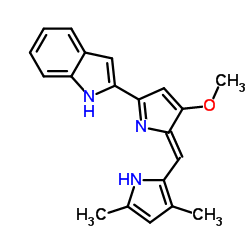803712-67-6
| Name | Obatoclax |
|---|---|
| Synonyms |
Obatoclax
2-{(2Z)-2-[(3,5-dimethyl-1H-pyrrol-2-yl)methylidene]-3-methoxy-2H-pyrrol-5-yl}-1H-indole QN4128B52A 1H-Indole, 2-[(2Z)-2-[(3,5-dimethyl-1H-pyrrol-2-yl)methylene]-3-methoxy-2H-pyrrol-5-yl]- 2-{(2Z)-2-[(3,5-Dimethyl-1H-pyrrol-2-yl)methylene]-3-methoxy-2H-pyrrol-5-yl}-1H-indole |
| Description | Obatoclax (GX15-070), a BH3 mimetic, is a pan-BCL-2 family proteins inhibitor with a Ki of 220 nM for BCL-2[1][2]. Obatoclax induces autophagy-dependent cell death and targets cyclin D1 for proteasomal degradation. Obatoclax has anti-cancer and broad-spectrum antiparasitic activity[3][4]. |
|---|---|
| Related Catalog | |
| Target |
BCL2:200 nM (Ki) Mcl-1:1-7 μM (Ki) Bcl-xL:1-7 μM (Ki) Bcl-W:1-7 μM (Ki) Bcl-B:1-7 μM (Ki) |
| In Vitro | Obatoclax (GX15-070) inhibits BCL-2, BCL-XL, MCL-1, BCL-w, A1, and BCL-b with Ki values≈1-7 μM[2]. Obatoclax (50-200 nM; 24-72 hours) induces a dose- and time-dependent reduction of cell numbers in all human colorectal cancer cell lines. In particular, the IC50 of cell proliferation at 72 h are 25.85, 40.69, and 40.01 nM for HCT116, HT-29, and LoVo cells, respectively[1]. Obatoclax (400 nM; for 24 hours) induces autophagy in OSCC cells[3]. Obatoclax (50-200 nM; for 24 hours) provokes a dose-dependent increase in the G1-phase cell populations[1]. Obatoclax (25-200 nM; for 24 hours) indicates a marked drop in cyclin D1 levels as low as 50 nM[1]. Obatoclax induces T286 phosphorylation-dependent or -independent cyclin D1 degradation.in HCT116 and LoVo cells, the steady-state levels of p-Cyclin D (T286) began to decline once exposed to obatoclax (200 nM; 1, 3, 6, 12, 24 hours). Obatoclax inhibits GSK3β but activates p38 MAPK, while barely affecting ERK1/2 activity in HT-29 cells[1]. Obatoclax (50, 100, 150, 200, 250, 300, 350, 400, 450 nM) potently inhibits the clonogenic potential of oral cancer cells[1]. Cell Proliferation Assay[1] Cell Line: human colorectal cancer HCT116, HT-29 and LoVo cells Concentration: 50, 100, 200 nM Incubation Time: 24, 48, and 72 hours Result: Induced a dose- and time-dependent reduction of cell numbers. Cell Autophagy Assay[3] Cell Line: AW8507 and SCC029B cells Concentration: 400 nM Incubation Time: 24 hours Result: Induced autophagy in OSCC cells. Cell Cycle Analysis[1] Cell Line: HCT116 and HT-29 cells Concentration: 50, 100, 200 nM Incubation Time: 24 hours Result: Provoked a dose-dependent increase in the G1-phase cell populations. Western Blot Analysis[1] Cell Line: HCT116, HT-29 and LoVo cells Concentration: 50, 100, 200 nM Incubation Time: 24 hours Result: Indicated a marked drop in cyclin D1 levels as low as 50 nM. |
| In Vivo | Obatoclax (GX15-070; 1.15-5 mg/kg; intravenously injected; five consecutive days) exhibits potent antitumor activity in xenograft mouse models in a dose-dependent manner[4]. Animal Model: 6-8 weeks old female BALB/C nude mice bearing subcutaneous tumors[4] Dosage: 1.15, 2.5, 5 mg/kg Administration: Intravenously injected (through lateral tail vein); five consecutive days (i.e. 5 injections) Result: Exhibited potent antitumor activity in xenograft mouse models in a dose-dependent manner. |
| References |
| Density | 1.2±0.1 g/cm3 |
|---|---|
| Boiling Point | 570.5±50.0 °C at 760 mmHg |
| Molecular Formula | C20H19N3O |
| Molecular Weight | 317.384 |
| Flash Point | 298.8±30.1 °C |
| Exact Mass | 317.152802 |
| LogP | 3.89 |
| Vapour Pressure | 0.0±1.5 mmHg at 25°C |
| Index of Refraction | 1.652 |
| Storage condition | -20°C |
